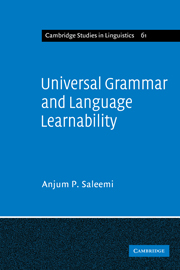Book contents
- Frontmatter
- Contents
- Preface
- 1 The problem of language learnability
- 2 The components of the linguistic system
- 3 The components of the learning system
- 4 Approaches to parameter fixation
- 5 The scope and limits of the current approaches
- 6 The distribution and variety of null subjects
- 7 Augmented parameter fixation: pro subjects and learnability
- 8 Review and integration
- Notes
- References
- Index
6 - The distribution and variety of null subjects
Published online by Cambridge University Press: 04 August 2010
- Frontmatter
- Contents
- Preface
- 1 The problem of language learnability
- 2 The components of the linguistic system
- 3 The components of the learning system
- 4 Approaches to parameter fixation
- 5 The scope and limits of the current approaches
- 6 The distribution and variety of null subjects
- 7 Augmented parameter fixation: pro subjects and learnability
- 8 Review and integration
- Notes
- References
- Index
Summary
In this chapter the licensing and parametric mechanisms underlying the null-subject parameter are reanalysed, in large measure relying on data previously reported in some of the vast literature on the topic (see Jaeggli and Safir 1989b for a state-of-the-art survey and references). The resulting formulation of the parameter is considered from a learnability point of view in the following chapter. Various approaches to the licensing and identification (i.e. interpretation) of null subjects are critically reviewed, leading up to a different view of the licensing and the parametric variation. The key feature of our account of the licensing is that null subjects are held to primarily follow from the optionality of the assignment of Case by Infl (cf. Bouchard 1984, Rizzi 1986a, Safir 1984, 1985). Moreover, following Rizzi (1986a) and Jaeggli and Safir (1989a), we consider the identification of the referential content and features of null subjects to be formally separate from their licensing. Consequently, in much of this chapter we concentrate on the licensing, assuming that an appropriate identification mechanism (see Jaeggli and Safir 1989a for a review) would be available once the licensing convention is in place.
Further, under our analysis the parameterization is considered to be characterized by greater diversity. As pointed out in the previous chapter, the parameter in question has been cited as evidence both for and against the subset principle. To recapitulate, it has been claimed that, in the relevant respect, a language generated by the pro-drop option includes a language generated by the non-pro-drop option (e.g. see remarks in Berwick 1985: 291–3).
- Type
- Chapter
- Information
- Universal Grammar and Language Learnability , pp. 90 - 111Publisher: Cambridge University PressPrint publication year: 1992



